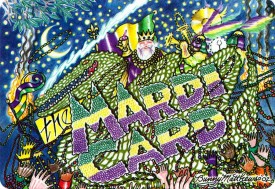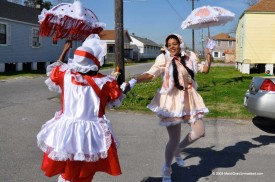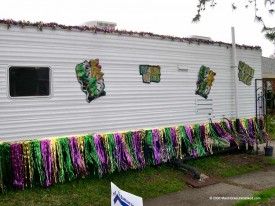We believe in the wisdom of fools and the true spirit of Mardi Gras: an optimistic and enduring human capacity for merriment and make-believe, for mirthful mockery and the creative indulgence of whimsy, as expressed through a remarkable amalgamation of homegrown customs and traditions. Our mission is to showcase this spirit, and deepen the public’s appreciation of Mardi Gras as a cultural attraction.
Channeling the true spirit of Mardi Gras
Mardi Gras Traditions operates on the premise that Mardi Gras can be experienced on many different levels and is not so much an “event” as a cultural phenomenon — a veritable cornucopia of processions, artistic pursuits and homegrown rituals that, collectively, make for one of the most multifaceted celebrations on the planet. Indeed, beyond the fancy-dress balls, glitzy parades and mass inebriation and immodest exhibitionism on Bourbon Street is a profusion of “unofficial” goings-on that represent an authentic and compelling expression of indigenous folkways.
2002 Mardi Card cover by Bunny Matthews
An incisive distillation in a handy printed format, but the Internet offered a glimmer of hope for something potentially more exciting.
Mardi Gras Traditions evolved from MardiCard.com, an offshoot of a pocket fold-out guide to Mardi Gras. Introduced in 1997, The Mardi Card included street maps, parade routes, listings and locations of live music venues, a detailed rundown of Carnival-related events and activities that were accessible to the public, plus Mardi Gras-related exhibits and attractions, a glossary of terms, an FAQ and information about how to catch a ride on a Mardi Gras parade float. In short, a convenient distillation of essential information including the skinny on grassroots happenings and “fringe” Carnival groups often overlooked by other media.
We still strive to thoughtfully document, and provide compelling insight into, the amorphous abundance that is Mardi Gras in New Orleans — and the endless array of colorful characters associated with it.
Transitioning to the Internet
Million Dollar Baby Dolls in the Ninth Ward, Carnival Day 2009
Mardi Gras has everything from big parades with marching bands and fantastic floats to spontaneous eruptions of dance and joie de vivre in the street; from debutante tea parties and elaborately choreographed balls to offbeat expressions of indigenous culture on neighborhood back streets.
Initially conceived as an online marketing vehicle for The Mardi Card, the site expanded along with the scope of our editorial efforts, becoming an outlet for documenting the festivities through photography and reportage. The Mardi Card ceased publication after Mardi Gras 2002. By then, MardiCard.com had morphed into MardiGrasUnmasked.com. The Internet offered not only the obvious advantage of reaching a broader audience in a more cost-effective and timely way, but also a glimmer of hope for something potentially more exciting: a day when technology would make it possible to present Mardi Gras as an immersive online experience.
In truth, our online endeavor has always been more a labor of love than a business — fueled by a belief in the wisdom of fools and an appreciation for Mardi Gras as the civic ritual that best exemplifies the astounding cultural richness of New Orleans.
After the storm
The catastrophe of Hurricane Katrina, having put the hurt on so many torchbearers of local culture, caused us to refocus our efforts. No longer could we take the city’s unique heritage and vernacular traditions for granted. And no longer could we abide the distorted projections of New Orleans and Mardi Gras in the mass media.
New Orleans has its share of problems, not doubt. But it’s not a city overwhelmed by poverty and dysfunction, abandoned to gun-toting thugs. And as much as the national media likes to traffic in titillation, playing up the risqué side of Mardi Gras revelry, the gala has in fact retained much of its traditional family orientation.
FEMA trailer decorated for Mardi Gras
The Mardi Gras spirit is associated with optimism and positive thinking, as was demonstrated by the heroic determination of New Orleanians, in spite of the devastation wrought by levee failures, to successfully stage Mardi Gras in 2006 – which helped the city believe in itself again.
As it turned out, the city’s most important cultural institution would not only offer a respite from harrowing loss and displacement, as well as a cathartic forum for channeling frustration and delivering satirical commentary through costuming and parade themes. It also provided an opportunity for people to take control of their own destiny and make an affirmative statement to the world: We’re here; the city is open for business and can handle a big event; and we will honor and preserve the traditions we hold dear. Mardi Gras, in other words, helped New Orleans overcome the trauma of Katrina and believe in itself again. Mardi Gras Traditions was proud to help promote this rejuvenation, always heeding the words of New Orleans writer Robert Tallant:
“I think if there is any world left in which human beings still laugh and still, even on rare occasions, have fun, there will be Mardi Gras, and that it will live through whatever catastrophes occur…,” he opined in his 1947 book Mardi Gras…As It Was. He went on to observe that, “Men cease to laugh only when they are very ill or when they have become beasts…. That is why Mardi Gras is not a trivial matter but a very important one. In a way it is a symbol of the art of being human, and wherever people are still human, wherever they still enjoy living, it will exist in some form.”
Keeping pace with technology
In recent years, we’ve tried to keep our eye on changes in Mardi Gras, which has seen a heartening influx of new grassroots groups embracing do-it-yourself artistry, as well as technology innovations. For Mardi Gras 2017, we’re introducing a new iteration of Mardi Gras Traditions. Our modus operandi has been to deconstruct the overall presentation, eliminating clutter to achieve a cleaner, more stripped-down aesthetic.
At the same time, we’ve deployed underlying technology based on the new standard for structuring and presenting electronic content, HTML5. Our ultimate goal is an online environment that renders beautifully on tables and mobile devices, and that functions more like an app than a traditional website. In practical terms, this means more functional, faster-loading pages and fewer navigational clicks — or, in the case of the iPad, swipes — to find the information you’re looking for.
It has been a steep learning curve, but we’re excited about the prospect of upgrades allowing us to spend less time managing the site and more time posting and promoting. In the meantime, please bear with us as we work through the process of porting archival content to the new platform and adding updated information and new features.
MardiGrasTraditions.com



